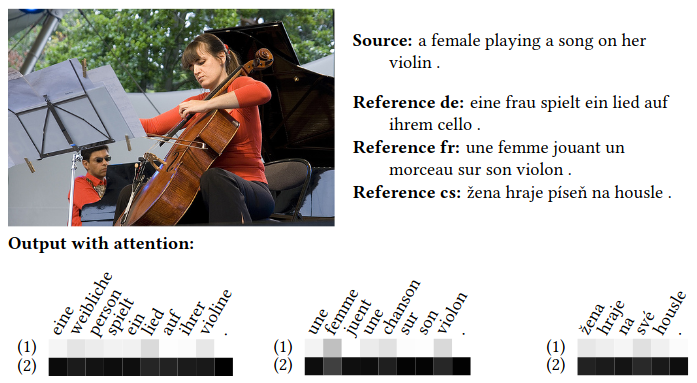Machine Translation Weekly 82: Multimodal Translation and the Visual Context
This week I am going to discuss (and criticize) a paper on multimodal machine translation that attempts to once again evaluate if and how the visual information could be useful in machine translation. The title of the paper is Good for Misconceived Reasons: An Empirical Revisiting on the Need for Visual Context in Multimodal Machine Translation, it has authors from several institutions in China and Hong Kong and will appear at this year’s ACL.
Multimodal machine translation (also, a topic of my dissertation) is defined as translation of image captions when both the caption text and the image itself are the input of the translation system. There is a specialized dataset for that called Multi30k with 30k simple sentences accompanied with images. Over time, the dataset became too easy from the translation perspective and people started to suspect that the visual information might be useless for such an easy translation. After all, there are relatively few cases when the visual information can really help (mostly gender in the target language and rarely some ambiguities). Models that claimed to improve translation quality fell under suspicion of being only regularizers. The first paper that tried to resolve this was an EMNLP 2018 paper by Desmond Elliott that introduced adversarial evaluation: he tried providing the models with incompatible caption-image pairs and observed if the translation quality drops. For some models it does (they indeed use the image), for some it does not. A paper that got the best-paper award at NAACL 2019 tested the models’ multimodal capabilities differently: they masked out some input sentence words and showed that the models were able to get the relevant information from the image. This shows that the models are in principle multimodal, but in most cases, it just does not pay off to check the image.
The newest ACL paper claims to develop an interpretable model with a gate explicitly letting the visual information to the model. The model reaches a similar improvement in the translation quality as other multimodal models, but the gate learns to be closed all the time. The adversarial evaluation shows that the results are only negligibly affected by feeding a different input. From this, they conclude their models and neither other models (which just happened not to be that interpretable) do not use the visual information.
Well, I do not think so. The conclusions of the paper are true only for the particular model it works with – and the model is a particularly bad choice. This model uses quite a weak image representation. They use a single vector from pre-trained ResNet. Models that pass the adversarial evaluation use more informative image features: either image region features from ResNet or features from object detection models such as Faster R-CNN or YOLO. The history of multimodal translation is about finding ways how to better represent the image and how to make the training signal from the image more concentrated (e.g., by using deliberating networks) to make use of the visual information. This goes in the opposite direction and indeed the result is that the visual is that the visual information is not used.
Moreover, the gating model the paper introduces is not the only model that offers this sort of interpretability. Our hierarchical attention from 2017 offers the same interpretability, but unlike the model from this paper, it can work with image region features and computes the gate specifically for each output word. This is a screenshot from my dissertation (Figure 5.3; the first line in the heatmaps is attention to the source sentences, the second line is the attention to the image):

It shows that although most of the time, the decoder only attends to the source sentence, it partially attends to the image when generating nouns. I believe the reason is that the hierarchical attention uses a more detailed image representation and a stronger mechanism to obtain information from the image. If we averaged everything, indeed the weight of the image would be almost zero. After all, the problem with multimodal translation is to some extent similar to document-level machine translation. The document-level context changes the translation in very few places. On average, it is almost useless, so the model easily learns to ignore it. For me, this paper only shows that the encoder-decoder model cannot make use of a weak training signal when a much stronger training signal is present – which is in fact nothing new.
Share the post
@misc{libovicky2021blog0607,
author = "Jindřich Libovický",
title = "Jindřich's Blog -- Machine Translation Weekly 82: Multimodal Translation and the Visual Context",
year = "2021",
month = jun,
url = "https://jlibovicky.github.io/2021/06/07/MT-Weekly-Multimodal-Translation-and-the-Visual-Context",
note = "Online, Accessed: 02.04. 2025"
}